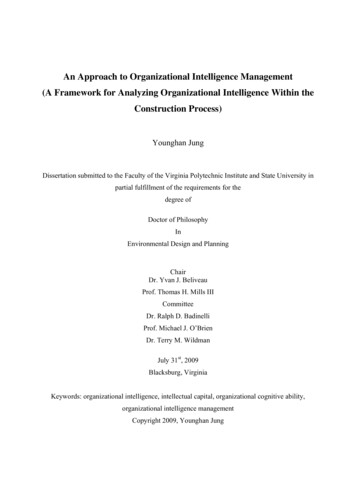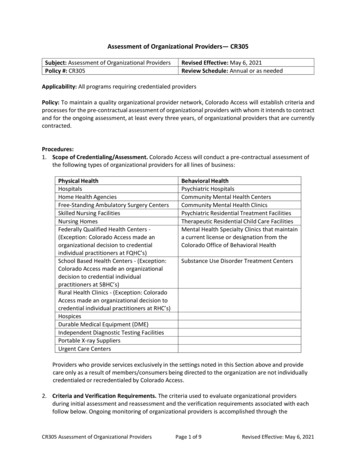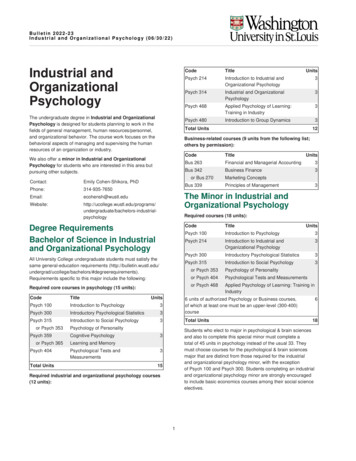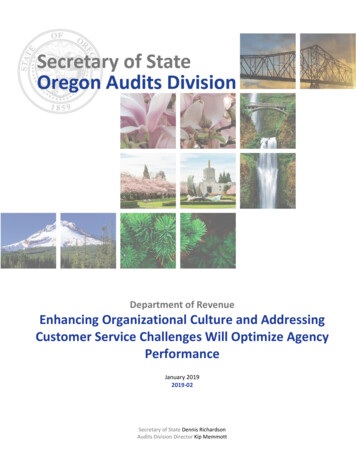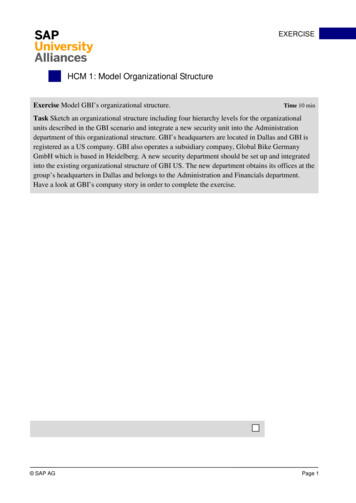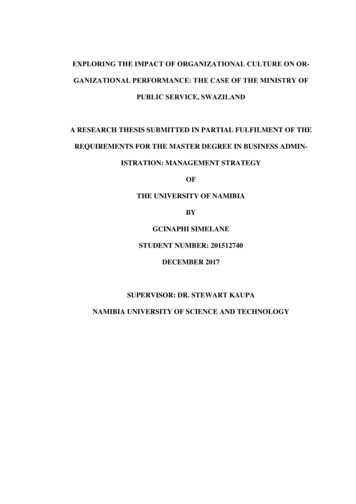
Transcription
EXPLORING THE IMPACT OF ORGANIZATIONAL CULTURE ON ORGANIZATIONAL PERFORMANCE: THE CASE OF THE MINISTRY OFPUBLIC SERVICE, SWAZILANDA RESEARCH THESIS SUBMITTED IN PARTIAL FULFILMENT OF THEREQUIREMENTS FOR THE MASTER DEGREE IN BUSINESS ADMINISTRATION: MANAGEMENT STRATEGYOFTHE UNIVERSITY OF NAMIBIABYGCINAPHI SIMELANESTUDENT NUMBER: 201512740DECEMBER 2017SUPERVISOR: DR. STEWART KAUPANAMIBIA UNIVERSITY OF SCIENCE AND TECHNOLOGY
ABSTRACTThe study aimed at assessing the impact of organizational culture on organizationalperformance in Swaziland using the Ministry of Public Service as a case study. Thekey objectives of the study were to evaluate the existing organizational culture andits impact within the Ministry of Public Service, and to determine the organizationalculture that is most effective for the Ministry of Public Service so that this informshuman resource management strategies and policy. A mixed method approach thatallows the use of both quantitative and qualitative methods was adopted with theaim of enhancing the robustness of the research findings. The study revealed thatcurrently the Ministry of Public Service is characterized by a hierarchical leadershipstyle which was rigid in terms of innovation and provision of customized solutionsfor its customers, particularly within government ministries. Further to that, thestudy also reveals that there is the absence of a roadmap that will collectively attainthe ministry’s objectives. The study recommends that a match of the organizationalculture with business strategy should be designed and implemented with the intentof delivering superior performance within the Ministry of Public Service. Finally,the study also recommends that leadership within Ministry of Public Service develops a strategic plan to articulate the business objectives and the indicators that willeffectively reflect the organizational goals.Key words: Organisational culture, Ministry of Public Service, Organisational Performance, Corporate Strategyi
TABLE OF CONTENTSABSTRACT .iList of Tables . . .ivList of Figures. vList of Abbreviations and Acronyms . viiACKNOWLEDGEMENTS . viiDEDICATION . viiiDECLARATION . ixCHAPTER ONE . 1INTRODUCTION AND BACKGROUND OF THE STUDY. 11.1 Introduction .11.2 Background of the study .11.3 Statement of the problem .31.4 Research Objectives .51.5 Significance of the study .61.6 Limitations of the study .61.7 Delimitation of the study .71.8 Structure of the study .7CHAPTER TWO . 92.1 Introduction .92.2 Definitions of Key Terms .92.3 Organisational culture .102.3.1 Strong culture vs. weak culture .132.3.2 Private vs. public sector organisational culture.152.4 Development of organizational culture .162.5 Measurement of organisational culture.172.5.1 Process-oriented approach .172.5.2 Classification approach .172.6 Organisational culture assessment models .182.6.1 Organisational Culture Assessment Instrument (OCAI) .192.6.1.1 Clan culture .212.6.1.2 Adhocracy culture .212.6.1.3 Market culture .222.6.1.4 Hierarchy culture .222.6.2 Denison organisational culture model .232.6.3 Schein's three-level model .262.7 Organisational performance.272.7.1 Measuring organisational performance .282.8 Impact of organisation culture on performance .292.9 Conclusion .303.1 Introduction .313.2 Location of the study .313.3 Research design .313.4 Population .333.5 Sample .333.6.1 Pilot Study .363.6.2 Questionnaire Design .363.7 Data Collection Procedure .383.8 Data Analysis .383.9 Reliability .39ii
3.10 Validity .393.11 Research Ethics .403.12 Conclusion .41CHAPTER FOUR . 424.1 Introduction .424.2 Results .424.2.1 Interview with Heads of Departments .424.2.1.1 Organizational Performance .434.2.1.2 Organisational Culture .454.2.1.3 Strategy Alignment .464.2.2.1.1 Sub-Dimensions of OCAI.524.3 Discussion of the results .654.3.1 The existing culture within MoPS .664.3.2 The impact of organizational culture on organizational performance inMoPS .694.3.3 The most effective organizational culture for MoPS.734.4 Conclusion .775.1 Introduction .785.2 Summary of the findings .785.2.1 Specific conclusions .795.3 Recommendations to policy and practice .835.3.1 Scope for further research .845.4 Conclusion .85REFERENCES .86APPENDIX A.961APPENDIX B .963APPENDIX C.974APPENDIX D.978iii
List of ferred . .52Table 4.2: Discrepancies in overall culture and sub-dimensions between now andpreferred 54iv
List of FiguresFigure 2.1: Organizational Culture Assessment Instrument (OCAI) 25Figure 2.2 Denison organizational culture model . 28Figure 2.3: Schein’s three level model of organizational culture . 30Figure 4.1: OCAI plot for dominant characteristics . .56Figure 4.2: Scores for organizational leadership .58Figure 4.3: Scores for management of employees .59Figure 4.4: Scores for organizational glue . .61Figure 4.5: Scores for strategic emphasis . .62Figure 4.6: Scores for criteria of success . . .64Figure 4.7: Scores for all dimensions . .65v
List of Abbreviations and AcronymsCVFCompeting Values FrameworkHoDHead of DepartmentMoPSMinistry of Public ServiceNPMNew Public ManagementOCAIOrganizational Culture Assessment InstrumentPMSPerformance Management SystemPPCUPolicy & Program Coordinating Unitvi
ACKNOWLEDGEMENTSMy sincere gratitude goes to my Thesis Supervisor Dr. Stewart Kaupa, the NamibiaBusiness School (NBS) MBA coordinators and the Institute of Development Management (IDM) Swaziland MBA coordinating team. You have all challenged andstretched me to endure and adapt to demands of this programme. Thank you.I would also like to thank my classmates, the NBS MBA class of 2015 in Swaziland,as the first group in this NBS, IDM partnership; we stuck it out with all the challenges. I got strength in knowing that I was not alone. I also express profound appreciation to my Department at work, Human Resource Development (HRD). Tomy supervisor who believed in me enough to invest in the MBA programme, to thecontinued support I received from colleagues while I juggled work and studies,thank you all.To my sisters, you have proven that it is the quality of family and not the number ofmembers that matters. Particular appreciation goes to Sebe. You have been a sister,a mother, a friend and most of all a pillar in all my aspirations. Thank youNabongwane. To my aunt ‘Khulu’, thank you for supporting me as if I were yourown daughter.A special appreciation and heartfelt gratitude goes to my daughter, KhethwelihleDlamini for your endless love and compromise. To God I give all the glory, thehonour and praises. You walked with me all the way; your unwavering supporthumbles me.vii
DEDICATIONTo my beloved daughter Khethwelihle Nthabiseng Langeni Dlamini, whom I willalways be indebted to for the unconditional love and support during this journey.viii
DECLARATIONI, Gcinaphi Simelane, hereby declare that this study is my own work, that it is a truereflection of my research, and that this work, or any part thereof, has not been submitted for a degree at any other institution.No part of this dissertation may be reproduced, stored in any retrieval system, ortransmitted in any form, or by any means (e.g. electronic, mechanical, photocopying, recording or otherwise), without the prior permission of the author, or The University of Namibia in that behalf.I, Gcinaphi Simelane, grant The University of Namibia the right to reproduce thisdissertation in whole or in part, in any manner or format, which The University ofNamibia may deem fit. .Name of StudentSignatureDateix
CHAPTER ONEINTRODUCTION AND BACKGROUND OF THE STUDY1.1 IntroductionThis chapter presents the background of the problem, statement of the problem, objectives, research questions, and significance of the study, scope of the study, definition of terms and limitations of the study.1.2 Background of the studyAccording to Kandula (2006), the key to good performance is a strong culture. Theaforementioned author further states that the differences in organizational culturescan result in the same strategy producing different results for two separate organizations. Denison (2011, p.9) refers to organizational culture as“the underlying values, beliefs and principles that serve as a foundation foran organization's management system, as well as the set of managementpractices and behaviors that both exemplify and reinforce those basic principles”.Kotter and Heskett (2010) concur with the claim that organizational culture is paramount to high and sustained organizational performance. In their study of 207 organizations over a period of 11 years, the scholars observed that organizations witha resilient and adaptive culture recorded financial and economic performance ofover 600% in revenue, net income and stock prices respectively. Therefore, organizational culture is increasingly being identified as a key factor in organizational performance and it is against this backdrop that most organizations are rethinking whatthey do and how strategic goals and objectives can be optimally attained (Cameron& Quinn, 2011). An advocate of organizational effectiveness advances that transformation and improvement of organizational culture is largely dependent on thedevelopment and implementation of a culture measurement tool (Cameron & Quinn,2006).1
A strong culture can be characterized by a coherent set of beliefs, values, assumptions and practices embraced by most members of the organization. A weak culturecan be described as one with core values that are not explicit and embraced by thepublic servants it had set out to do. The Programme and Policy Coordinating Unit(PPCU) measures the attainment of performance targets in Swaziland Government(Riley, 2014). In an effort to address inefficiencies emanating from weak organizational culture, governments in developing countries or first world states introducedthe new reform agenda referred to as New Public Management (Beck & Bozeman,2007). The latter scholars state that the global view of the New Public Management(NPM) reform agenda suggests that governments can benefit from working withinthe organizational culture to reap similar outcomes like those organizations in theprivate sector. The Ministry of Public Service (MoPS) can benefit from assessingthe impact of the ministry’s culture towards its performance with the intention ofimproving the perceived current low performance ratings (Swaziland. Prime Minister’s Office, 2013). In this context, organizational performance refers to achievingthe goals that the organization has set by using non-financial indicators such as timeliness (efficiency), quality of output and productivity level of the Ministry. A consideration as highlighted by Schein (2010) is that the growing interest in understanding organizational culture as a contributing factor to organizational performance hasled to the conclusion that culture can be thought of as an organizations’ DNA, whichcan be a powerful template that shapes what happens in the workplace.MoPS is one of three central agencies in Swaziland Government and is mandated tocreate an enabling environment for all the Government Ministries to deliver qualitypublic services in the most efficient and effective manner. The mandate is to be2
achieved through the following objectives: To attain effective general public servicemanagement, to ensure performance improvement and to attain effective development and utilization of human resources (retrieved from http//www.gov.sz). In his‘Speech from the throne 2013’, His Majesty King Mswati III directed government tostart operating like a business, to be results oriented in its operations similar to theprivate sector (Swaziland. Prime Minister’s Office, 2013). This saw the formulationof the National Strategic Plan themed ‘Programme of Action 2013-2018’ where strategic performance targets for all Government Ministries were set to be implementedfor the period of 5 years (Swaziland. Prime Minister’s Office, 2013). The five-yearperformance target for MoPS is ‘a productivity improvement programme embracinga healthy and effective public service and improved service delivery implementedand sustained by 2018’ (Swaziland. Prime Minister’s Office, 2013).The aim of this study is to explore the impact of organizational culture towards performance in the MoPS, with focus on determining the significance of the role of culture efficacy in service delivery. It is anticipated that insight will inform leadershipand management practices within the Ministry of Public Service and by extensionall government Ministries in Swaziland. Furthermore, the findings of this study willallow for contributions to be made towards the implementation process of the Performance Management System (PMS) which is anticipated to commence in the financial year 2017/18.1.3 Statement of the problemMoPS is tasked with the function of formulating and implementing relevant humanresource policies to foster optimal utilization of the human resource in the all government ministries with the aim of achieving organizational objectives effectively.3
In 2009, the Government of Swaziland through the Prime Minister’s Office introduced performance agreements for ministers and principal secretaries in Swaziland’sGovernment. The terms contained in the agreement provides for a five-year performance program in which all principal secretaries are required to attain or exceed atarget of 80%, with a performance review conducted on a quarterly basis. This fiveyear programme is measured against the non-financial performance indicators highlighted above in the background of study. At the end of each financial year the fourquarter ratings are collated to derive the overall performance for the Ministry ofPublic Service.To ensure continuous monitoring and evaluation, the Prime Minister’s Office established the Policy & Program Coordinating Unit (PPCU) that is responsible for theimplementation of national development programs and policies. Since inception ofthis program MoPS has been receiving relatively low ratings, Swaziland. PrimeMinister’s Office, 2013. The PPCU Review revealed that the ministry received anaverage rating of 40% in 2015. The connotation that this underperformance withinMoPS as stated in the PPCU reviews is likely to have detrimental effects to theoverall performance of Swaziland Government Ministries. This is because the mandate of MoPS is mainly focused on ensuring that the relevant programmes and policies are in place to steer the human resources in government to deliver services effectively and efficiently. The underperformance of MoPS negatively affects the performance of all the other government ministries in terms of fully utilizing humancapital in attaining organizational goals. Therefore, this implies how the governmentmachinery would be affected. A recent study points out that the vision of the publicservice is achievable through significant change in the way people work. To be a4
responsive organization a change in culture, structure and processes becomes imperative (Ireland Department of Public Expenditure and Reforms, 2014). Worth notingis that recent studies have been done on organizational culture and organizationalperformance (Migendi, 2010; Onyamu, 2013; Owino and Kibera, 2015). While thereare various studies that explore the relationship between organizational culture andorganizational performance (Denison, 2011; Kotter, 2011; Schein, 2010), thereseems to exist a lack on research focusing on the correlation of the two constructs inthe context of Government or Public Sector. Therefore, a gap exists in studies pertaining to the Swaziland context and this study therefore sought to fill this researchgap. Furthermore, there exists a gap in knowledge that may provide remedialmeasures for the Ministry of Public Service in addressing these low ratings in organizational performance.Given this background, the current study aimed at providing empirical evidence onthe prevailing culture and its impact on the performance of the Ministry of PublicService in Swaziland, with the intent to inform strategies and policies geared towards performance improvement.1.4 Research ObjectivesThe following primary objectives were designed in order to address the problemstatement presented above: To assess the impact of organizational culture on organizational performance in the Ministry of Public Service. To evaluate the existing organizational culture within the Ministry of PublicService.5
To determine the organizational culture that is most effective for the Ministry of Public Service.1.5 Significance of the studyThe findings from this study are aimed at contributing to theory, practice and validating existing knowledge in studies of organizational culture. This research is particularly different because it is useful in the context of Swaziland where there hasbeen no study that has been found by the researcher that has focused on the impactof organizational culture on organizational performance in the public sector insouthern Africa. Concepts presented may be used in conducting further researchwhen testing other related findings. The findings from this study are aimed at assisting human resource practioners in Government on the role that is played by organizational culture in the attainment of the organizational goals and objectives. Thefindings and recommendations of this study can be informative in the developmentand review of human resource policies and programs, by extension embrace the impact of organizational culture in the performance of MoPS. It is anticipated that thefindings will also serve as a template in the current process of rolling out the Performance Management System (PMS) in the Swaziland Government.1.6 Limitations of the studyThe main limitation of this study was the possibility that respondents may not havebeen truthful when responding to the questionnaires especially where the questionsbordered on their responsibility and accountability, this was a limitation. Due to thenature of the questions in the interview schedule, some of them require the respondent to take responsibility of inefficiencies that may have resulted in their depart-6
ments. However, in order to overcome this problem, the researcher probed participants using follow-on questions to validate responses. Another limitation pertainedto the generalizability of the findings to other government ministries. Since the otherministries were not part of this study, the analysis, results and recommendations ofthis research cannot be generic. In addressing the limitation, the researcher maderecommendations to explore further research with a wider scope of the governmentministries.1.7 Delimitation of the studyThe scope of the study was limited to the Ministry of Public Service in Swazilandand the findings of the study may not be applicable in the other government ministries. This scope of the study was necessitated by the timelines allocated for the thesis; a broader scope would not be achievable.1.8 Structure of the studyThe current study consists of five chapters, with Chapter One presenting an overview of this study. The first chapter has discussed the construct of organisationalculture and highlighted the problem that exists in the case of MoPS and the objectives of the research. In addition, its significance was argued in terms of contributingto the body of knowledge. Lastly, limitations and delimitations of the study werehighlighted.Chapter Two provides a review of the literature available on topic. The chapter presents an overview of concepts on organisational culture and its association to organisational performance, as well as reviewing the empirical and academic literature onthe tools utilised for assessment of organisational culture.7
Chapter Three focuses on the research methods of the study, which comprises of theresearch design, procedures for data collection and analysis procedures, and effortsemployed to ensure adherence to ethical issues.Chapter Four presents the results of the study and further discusses implications ofthese findings. Chapter Five provides a summary and conclusion based on the results of the study, and finally makes recommendations and possible considerationsfor further research on the subject.8
CHAPTER TWOLITERATURE REVIEW2.1 IntroductionThis chapter extensively reviews and discusses published (empirical, theoretical andacademic) literature pertaining on the impact of organizational culture on organizational performance. The review of literature in this exploratory study includes syntheses of existing literature to provide the fundamentals of the concept as well as tosupport the findings. The secondary data for this study was sourced from peer reviewed academic journals, books and Government reports. What are the key issuescovered in the chapter?2.2 Definitions of Key TermsThe terms in the study included those that are relevant to organizational culture andorganizational performance. Definitions benefit the reader of this research so thatthe meaning derived is within the context of the study.Organizational Culture: these are the core values, assumptions and beliefs thatembody the organization and the people working within it (Schein, 2010).Organizational Performance: refers to achieving the goals that the organizationhad set out to do (Kotter and Heskett, 2010).Organizational Climate: is a concept that precedes the notion of organization culture, it is how members of the organization experience the culture in the workplace(Denison, 2011).Business Excellence: the term is used to describe outstanding practice that achievesorganizational results (Eaton & Kilby, 2015).9
Corporate Strategy: this refers to the organization-wide plan to achieving its goals.It involves stating the scope and direction of all operations in the business (Kotter,2007).2.3 Organisational cultureRecently there has been an increase in interest from scholars to decode organizational culture and the impact it has on organizational performance (Kotter andHeskett, 2011; Denison 2011; Schein 2010). This concept has been examined to attribute optimal organizational performance of business and governments in developed countries like Japan and United States of America. Notably the researcher didnot find published literature in the context of developing countries, in particularthose with similarities to Southern Africa or Swaziland. Whilst there may exist studies on the impact of organizational culture on organizational performance in developed countries, they lacked the homogeneity aspect of the similarity in the socialization pattern of most the Southern African Development Community (SADC). Hofstede 2007 was found that the socialization pattern forms an essential component inthe concept of organizational culture. In this case as the above mentioned authorstates, SADC exhibits similarities in its national socialization pattern which is translated to the workplace.Hofstede, Hofstede and Minkov (2010) suggest that organ-izational culture also provides the fundamentals of understanding the distinction thatmay exist in successful organizations which operate in the same national culture.The aforementioned author further asserts that a distinct correlation exists betweenthe national and organizational
The study aimed at assessing the impact of organizational culture on organizational performance in Swaziland using the Ministry of Public Service as a case study. The key objectives of the study were to evaluate the existing organizational culture and its impact within the Ministry of Public Service, and to determine the organizational





